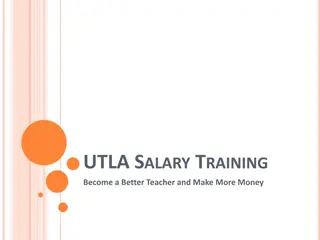Analyzing Free Agent Salary Predictions in NHL
Explore the use of traditional and advanced metrics to predict free agent salaries in the NHL. From basic counting stats to beta regression models, learn how statistical models can assist teams in making informed decisions on player contracts based on market prices and player value. Discover the challenges of linear models and the benefits of using beta regression for more accurate salary predictions.
Download Presentation

Please find below an Image/Link to download the presentation.
The content on the website is provided AS IS for your information and personal use only. It may not be sold, licensed, or shared on other websites without obtaining consent from the author. Download presentation by click this link. If you encounter any issues during the download, it is possible that the publisher has removed the file from their server.
E N D
Presentation Transcript
Predicting Free Agent Salaries with Traditional and Advanced Metrics Matt Cane @Cane_Matt puckplusplus.com hockey-graphs.com
Predicting Salaries: Why? Don t need stats or any models to know these were bad deals Statistical model can provide a sanity check Knowing what we expect a player to cost can help teams avoid big mistakes
Predicting Salaries: Why? Teams have limited resources to identify and pursue free agents Figuring out who may fit into your budget early is beneficial Useful to players to know what statistically similar players have been paid Don t want to leave money on the table Can help identify teams who overpay vs. market, or find cheap free agent talent Can help identify players whose price price (dollars) is different from their value value (wins) Bonus: Provides something for strangers on the internet to yell at you about when you suggest that their favourite player is overpaid
Basic Attempt: Linear Model Predict UFA Salaries with Basic Counting Stats Provided relatively good predictions Forwards R^2 = 0.76 Defence R^2 = 0.74 Problem with linear model Negative Predicted Salaries Can t force Colton Orr to pay $275K to play in the NHL Predicted vs Actual Cap Hit (July 1, 2015 UFAs) $7.00 Millions $6.00 $5.00 Actual Cap Hit $4.00 $3.00 $2.00 R = 0.6801 $1.00 $0.00 ($2.00) $0.00 $2.00 $4.00 $6.00 $8.00 Millions Predicted Cap Hit
Better Method: Beta Regression Player salaries are constrained to a set minimum/maximum value based on the CBA and Salary Cap Represent each contract as a percentage: Salary Percent = (Salary Minimum)/(Maximum Minimum) Each players salary is now represented as a number between 0 and 1 Use Beta Regression to create models that translate past results into predicted salary percentages Beta Regression restricts predictions to between 0 and 1 Gives flexibility in structure of prediction
Two Methods: Basic and Advanced Stats Basic Stats (Counting Stats): Represent the market price Games Played, Total TOI, EV Goals, Assists, PP Points, Age, SH/PP TOI, Penalties Taken, Hits Contract Type (Full UFA, Partial RFA/Partial UFA, RFA Bridge) Advanced Stats Represent the true value (assuming past wins are a good proxy for future wins) WAR-On-Ice WAR Total TOI Contract Type (Full UFA, Partial RFA/Partial UFA, RFA Bridge) Using previous 3 years of data (all data from War On Ice) to predict Salary Percent Model Forwards and Defencemen Separately Exclude players with salary < 1MM and Entry Level Contracts
Findings Raw values are better predictors than rate stats Raw values capture information about injuries, playing time, benchings, etc. Recent stats are more important than past stats Traditional metrics are better predictors than WAR Position Position Traditional Traditional Model R^2 Model R^2 WAR Model R^2 WAR Model R^2 Forwards 0.73 0.57 Defencemen 0.70 0.53
Application: Evaluating GMs Signings Compare predicted price to actual contract to identify players who may have been over/underpaid
Application: Evaluating GMs Signings Oilers signed their RFAs to reasonable deals (Bridge/UFA-RFA); UFAs have been paid above market value
Application: Evaluating GMs Talent Identification Compare WAR value to actual contract value to see if GMs pay for overall contribution in wins
Application: Finding Relatively Cheap Free Agents Predictions can help identify players whose projected Win Value is more than their Market Value
Future Enhancements Incorporate size of market in a given year When there are few options at a position, players should get higher salaries Incorporate past salary and buyouts Players with big contracts before may be more likely to get big contracts after Buyouts severely depress market price
For More Information Twitter: @Cane_Matt E-Mail: puckplusplus@gmail.com For copies of these slides, graphs for each team, and initial predictions for upcoming free agents please see: puckplusplus.com/contracts























